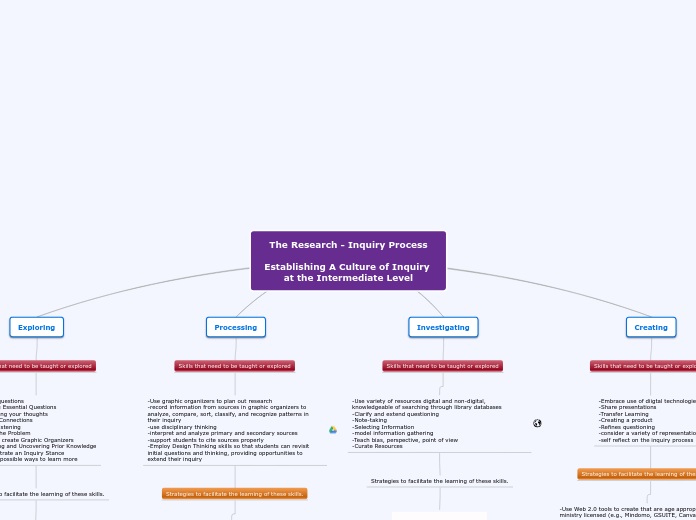von David Cruz Vor 6 Jahren
911
The Research - Inquiry Process

von David Cruz Vor 6 Jahren
911

Mehr dazu
-Use Web 2.0 tools to create that are age appropriate and ministry licensed (e.g., Mindomo, GSUITE, Canva, Adobe Spark) and allow students 24 hourequitable access -Share creations or ideas with other learners or stakeholders in the community through video conference, websites, social media, displays (e.g., Flipgrid, Skype, Hangouts) -Portfolio (e.g., use Brightspace ePortfolio, Seesaw, Google Sites, MyBlueprint, Sesame Snap) -self assess work using success criteria and disciplinary thinking to determine next steps of learning in an inquiry -identify avenues for action and celebrate their learning -reflect on what, how and why learning happened by connecting to learning goals and success criteria -Use Padlet, Google Forms to reflect on the assignment, unit, or inquiry process -Use Rubrics, checbrics, Met/Not met scales for further assessment and reflection
-Evaluating reliable sources (e.g., Fake News, Valid websites) -Using Jot notes -Voice Dictation -Use proper boolean search -model different ways to organize research, (e.g. mindmapping, sketchnoting, thoughtbook) -Use primary resources -Use digital curation tools (e.g., Google Keep, Pocket, Diigo) -Use Inquiry anchor charts -Create Inquiry Vocabulary word wall -co-create with students criteria needed to enable critical thinking and to evaluate information -Use the CRAAP Test
-Use of digital apps as graphic organizers (e.g., Popplet, Mindomo, Explain Everything) -Use historical thinking concepts (Historical Significance, Cause and Consequence, Continuity and Change, Historical Perspective - http://historicalthinking.ca/historical-thinking-concept-templates) -Activities and Graphic Organizers From 'Making Thinking Visible' (Connect-Extend-Challenge, Microlab Protocol) -co-construct success criteria with students to support them as they complete inquiry tasks -provide opportunities for self and peer assessment that revisit the initial engagement questions and reflect back on co-created success criteria -Use Easybib or citation machine to cite resources properly -Use Common Creative copyright tool
Strategies to facilitate the learning of these skills.
-Q-Chart -RAN Chart -KWL Chart -Mind Mapping -Graffitti -Place Mat -Padlet - Questioning and Brainstorming -Google Classroom - Asking Questions and having discussions -Use Peardeck Add-on for Google Slides to document possible questions and the learning process -Wonder Wheel -KWLAQ Chart - Make their thinking visible: Activities and Graphic Organizers From 'Making Thinking Visible' (ThinkPuzzleExplore,Zoom In, Chalk Talk) -Strategically model wondering and making predictions; encourage questions and acknowledge quality of questions being asked